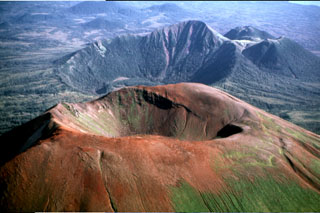Report on Edgecumbe (United States) — 13 April-19 April 2022
Smithsonian Institution / US Geological Survey
Weekly Volcanic Activity Report, 13 April-19 April 2022
Managing Editor: Sally Sennert.
Please cite this report as:
Global Volcanism Program, 2022. Report on Edgecumbe (United States) (Sennert, S, ed.). Weekly Volcanic Activity Report, 13 April-19 April 2022. Smithsonian Institution and US Geological Survey.
Edgecumbe
United States
57.05°N, 135.75°W; summit elev. 970 m
All times are local (unless otherwise noted)
AVO stated that a seismic swarm beneath Kruzof Island near Edgecumbe began at about 0200 on 11 April, and by 15 April several hundred earthquakes had been recorded. The number of events was unusual for that volcano. The magnitudes were generally M 1.7 or smaller, though a M 2.8 was detected on 11 April. The events were located at depths of less than 10 km, though the exact locations were difficult to constrain due to the lack of a local seismic network on the island; the closest station was in Sitka, 25 km E. The source of the swarm was unknown, and related either to tectonic processes or volcanic unrest, or a combination of both. Both the Volcano Alert Level and Aviation Color Code were Unassigned due to the lack of dedicated, local instrumentation. AVO noted that additional data from distant seismic stations was being analyzed, and several years of Synthetic Aperture Radar (SAR) data was being evaluated for topographical changes. No surficial changes were visible in recent satellite images and webcams views.
Geological Summary. The Edgecumbe volcanic field covers about 260 km2 of Kruzov Island west of Sitka in SE Alaska. The basaltic-to-dacitic field is dominated by the large composite cones of Mount Edgecumbe, Crater Ridge, and Shell Mountain. This Pleistocene-to-Holocene system is 16 km E of the Queen Charlotte-Fairweather transform fault separating the North American and Pacific plates. Mount Edgecumbe is a stratovolcano with a well-defined crater, and is the largest edifice of the field. Crater Ridge is truncated by a 1.6-km-wide, 240-m-deep caldera. These and other vents are oriented along a SW-NE line. Volcanic activity originated about 600,000 years ago along fissures cutting Kruzof Island. A series of major silicic explosive eruptions took place about 9,000-13,000 radiocarbon years ago. The latest dated eruptions were phreatomagmatic explosions during the mid-Holocene, and all postglacial activity has been pyroclastic. Reports of observed eruptions are unsubstantiated.
Source: US Geological Survey Alaska Volcano Observatory (AVO)

